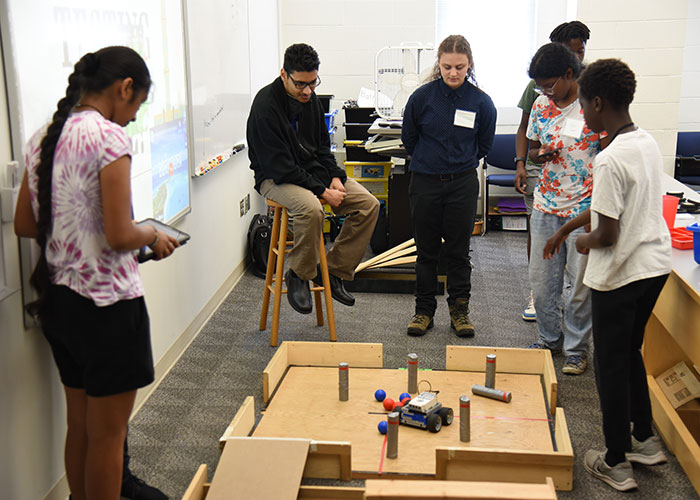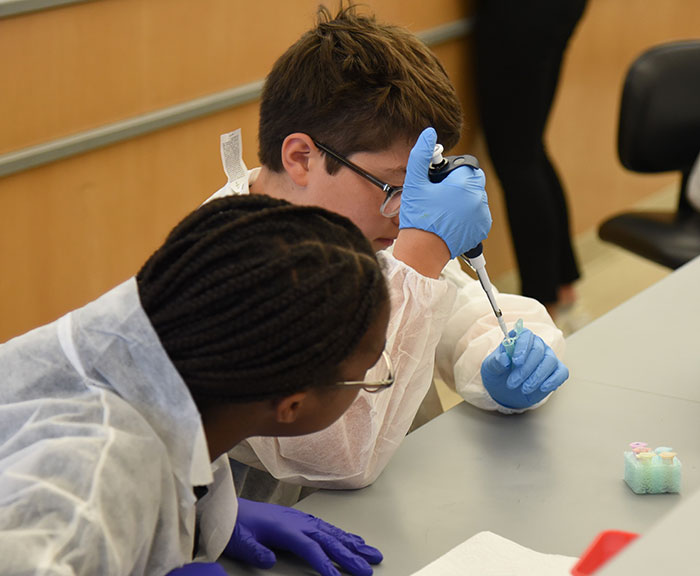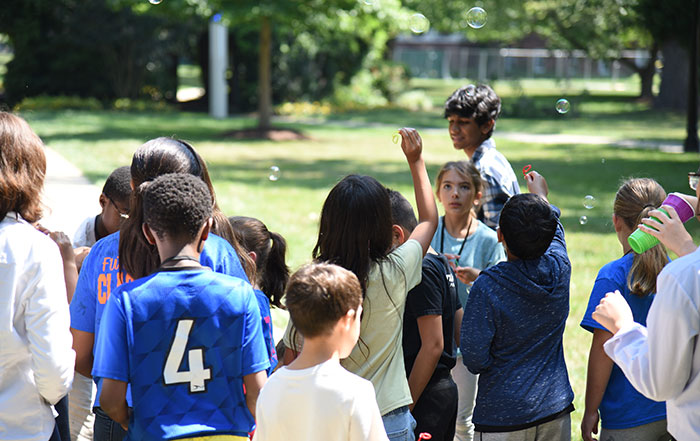Summertime Students Build Their Futures with MRDC's GEMS Program

Inside the Hodson Science Center on the campus of Hood College –located just a few blocks from Fort Detrick in Frederick, Maryland – the students taking part in the U.S. Army Medical Research and Development Command's annual Gains in Mathematics and Science program are raising their hands, asking questions and taking notes – the same as any other summer school class. Five minutes later however, those same students are building robots, reviewing DNA samples and using blood splatter analysis to solve a crime.
"We want to make learning fun and reach out to as many people as possible," says Chandini Montgomery, a STEM Education Specialist at USAMRDC and one of the program's organizers. "GEMS is a perfect way to make that happen."
The overall goal of the GEMS program is to promote science, technology, engineering and mathematics education to students across the country in grades four through twelve, with a specific focus on students historically underrepresented in STEM areas. To date, more than 550 students are scheduled to participate in the five-week event at Hood College, with more than 100 attending during the first week alone. Guiding them through their respective courses is a rotating cast of Near-Peer Mentors (usually high school or college students) and Resource Teachers (usually professionals with a teaching background).

"I love watching all the different ways they come up with solutions," says near-peer mentor Kira Anderson, referring to the nearly 20 students in her engineering class. A rising high school senior, Anderson is also a "GEMS Graduate," having participated in the program herself a few years ago – an experience which led her back to familiar terrain. "Seeing the kids work together is just so very cool," she says. "I mean, some of this stuff even I wouldn't know how to do – so it's wild to watch them grow."
The variety and scope of available classes remains a consistent draw for the Frederick-based portion of the program, with organizers fielding classes focusing on environmental science, computer coding and robotics; the latter allowing students to build and then race their own electric cars. The crime scene investigation class, which allows participants to use scientific analysis to solve a fictional crime – and which has long been a favorite of GEMS students – remains a course option this year as well.
Direct reporting units from across the MRDC footprint also participate in the annual event, with accompanying instructional modules designed to dovetail with each lab's respective mission. For instance, participants at MRDC's Walter Reed Army Institute of Research in Silver Spring will focus chiefly on biomedical topics, while GEMS students at MRDC's Research Institute of Environmental Medicine in Natick, Massachusetts will focus on topics related to biochemistry and biomechanics.
"I get to teach people why I love science," says Colin Kelly, another Near-Peer Mentor and previous "GEMS Graduate" who is currently majoring in Cell, Molecular and Developmental Biology at Purdue University. "It's very interesting," he says of the experience. "When I was doing the CSI class just a few years ago, at the time I didn't know what I wanted to do – so to come back to it, I get a lot of gratification from it."

Says resource teacher Cecily Smith, a 10-year veteran of the GEMS program and local English teacher, "What I appreciate about this particular course is that I get to see that light bulb turn on when something finally makes sense, when the kids start to understand the science. That's when I get excited."
The MRDC GEMS program runs until mid-August at most locations, with a dedicated two-week block of courses near the end of the program set aside solely for high school students. During the past several years – including those impacted by the COVID-19 pandemic – upwards of 1,400 students have participated annually in the GEMS program across all MRDC direct reporting units.
"These kids are at an age where they're trying their best to learn what they want to do in life," says Montgomery, "so if you make it fun for them, it will be much more impactful."
As the Army's medical materiel developer, MRDC has an enduring interest in developing the talent required to ensure the U.S. military maintains the medical capabilities to fight and win on the battlefield. MRDC is committed to fostering interest in STEM fields to facilitate the development of the Nation's future scientists; an effort which is seen as an investment in the long-term futures of both the respective students and the command as a whole.














